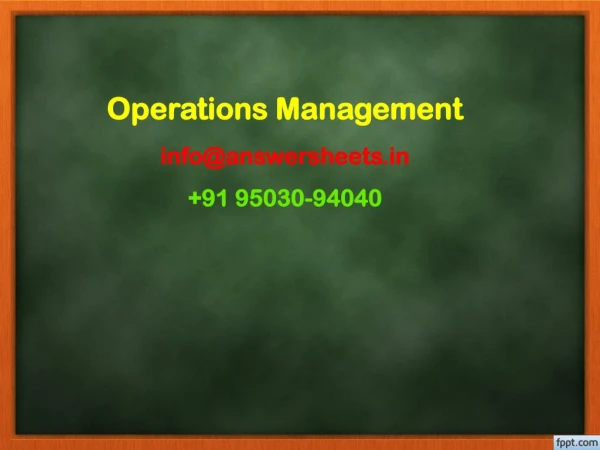A contractor has to supply 10,000 bearings per day to an automobile manufacturer.
www.answersheets.in info.answersheets@gmail.com info@answersheets.in 91 95030-94040 Operations Management Section A: 5 Marks Each (Attempt any 3) 1. Discuss the nature and scope of operations management in terms of production decisions. 2. Explain the product selection and stages involved therein. 3. What are the various kinds of production systems? Discuss the nature of Mass Production. 4. Discuss in brief how do you organise value engineering function in an electronic industry? 5. Define .Purchase Systems. What are the common objectives of the purchasing function? 1. Section B: 5 Marks Each (Attempt any 3) 2. Design an assembly line for a cycle time of 10 minutes for the following 10 workelements: 3. Elements : 1 2 3 4 5 6 7 8 9 10 Immediate predecessor : 0 1 2 2.3 4 5 6 5 7.9 9 Duration in minutes : 5 10 5 2 10 7 5 2 5 7 Discuss how a quality-management program can affect productivity. 4. Select three service companies or organizations you are familiar with and indicatehow process control charts could be used in each. 5. Explain the various factors that are to be taken into account for plant location. Discuss in connection with setting up an Automobile industry. 6. Explain the term 'Break-even analysis'. Draw imaginary BEP chart and briefly describe its merits and demerits. Section C: 10 Marks Each (Attempt any 3) 1. (a) Explain what you understand by the term "Total Quality Management", paying particular attention to the following terms :quality, supplier-customer interfaces, and process. (b) Define Productivity. List some factors that can affect productivity and some ways in which productivity can be improved. 2. (a) Give two examples (with supporting details) of the impact of technology in product and service design, in the context of service and manufacturing firms. (b) A firm uses simple exponential smoothing with α = 0.1 to forecast demand. The forecast for the first week of February was 500 units, whereas actual demand turned out to be 450 units. (i) Forecast the demand for the second week of February. (ii) Assume that the actual demand during the second week of February turned out to be 505 units. Forecast the demand for the third week of February. 3. (a) Bloomsday Outfitters produces T-shirts for road races. They need to acquire some new stamping machines to produce 30,000 good T-shirts per month. Their plant operates 200 hours per month, but the new machines will be used for T-shirts only 60 percent of the time and the output usually includes 5 percent that are "seconds" and unusable. The stamping operation takes 1 minute per T-shirt, and the stamping machines are expected to have 90 percent efficiency considering adjustments, changeover of patterns, and unavoidable downtime. How many stamping machines are required ? (b) Give an example of a business that would use a push and one that would use a pull operations control system. Explain your choice and briefly describe how the system works. 4. (a) What are the various methods of judgemental forecasting ? Comment on possible errors that are associated with judgemental forecasting. (b) A time study of a restaurant activity yielded a cycle time of 2.00 minutes, and the waitress was rated at PR = 96 percent. The restaurant chain has a 20 percent allowance factor, Find the standard time. 5. (a) What are the advantages of having a company-wide data-bank ? Show how different functions e.g. cost accounting, sales, inventory, manufacturing can be integrated with a data-bank. (b) A contractor has to supply 10,000 bearings per day to an automobile manufacturer. He finds that, when he starts a production run, he can produce 25,000 bearings per day. The cost of holding a bearing in stock for one year is Rs. 2 and the set-up cost of a production run is Rs. 1,800. How frequently should production runs be made ? (Assume 300 working days in a gear) Section D: 20 Marks 1. Write short notes on any five of the following: (a) Cellular manufacturing (b) ISO 9000 (c) Fish-bone Diagram (d) AGVS (e) Cross Impact Matrix (f) Benchmarking (g) CIM (h) Job Enlargement www.answersheets.in info.answersheets@gmail.com info@answersheets.in 91 95030-94040
★
★
★
★
★
128 views • 8 slides



















